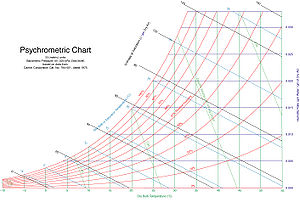Sensible Heat: is the amount of heat in air that can be measured by an ordinary thermometer. The daily weather report gives us sensible heat temperatures, but it does not represent the total heat we experience. It constitutes a portion of the heat resulting from air infiltration, ventilation and internal heat sources such as people, electric lights and electric motors. Sensible heat also results form heat leakage or solar radiation.
Latent Heat: is the amount of heat contained in the water vapor (moisture) in the air. It constitutes a portion of the heat resulting from infiltration and ventilation and any internal sources capable of adding water vapor to the air. The amount of latent heat in the air can be determined by using a psychometric chart. The amount of excess latent heat so determined will indicate the amount of moisture that must be removed from the air in order to obtain comfortable conditions.
 |
| Above is an example of a Psychrometric Chart |
Sensible heat gain is represented by a change in the dry-bulb temperature readings, where as latent heat gain is represented by a change in the web-bulb temperature.
This post was published by Tucson air conditioning service but was written by James Brumbaugh in the book "HVAC Fundamentals: Air Conditioning, Heat Pumps and Distribution Pumps (Volume 3)"